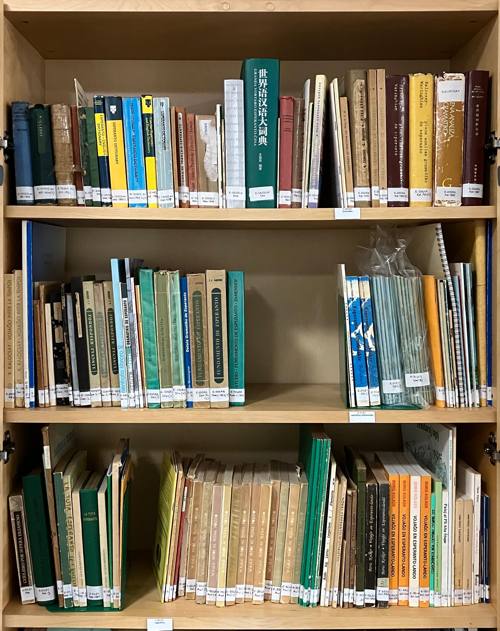 We are happy to inform you that the library at Esperanto House is finally ready to enable members to borrow from it. After 18 months of weekly work, all 2700+ books (and most of the periodicals) are catalogued, labelled, stamped and sorted on the shelves. The plan is to eventually set up an online loan system, but until then, there is a manual system, using a book. However, you can now see the catalogue as an online spreadsheet, at bit.ly/biblioteko-katalogo.
We are happy to inform you that the library at Esperanto House is finally ready to enable members to borrow from it. After 18 months of weekly work, all 2700+ books (and most of the periodicals) are catalogued, labelled, stamped and sorted on the shelves. The plan is to eventually set up an online loan system, but until then, there is a manual system, using a book. However, you can now see the catalogue as an online spreadsheet, at bit.ly/biblioteko-katalogo.
So, what will you find in the library? Well, what interests you? Is it biology? Maybe you would like the book Sekretoj de la marestaĵoj (Secrets of the sea creatures), by Petar Giunio. Cosmology? Davis Galadi-Enriquez and Amri Wandel wrote La kosmo kaj ni: Galaksio, planedoj kaj vivo en la universo (The cosmos and us: Galaxy, planets and life in the universe). There are also many books on geography, history and other specialist subjects. Of course, there are many books (in fact, more than 500) about Esperanto itself, including dictionaries, textbooks, and books about grammar, the history of Esperanto or the Esperanto movement, and studies about, and advice for, writing. There are even many books in English that argue for Esperanto. However, the largest main section of the library is literature, both original and translated, including novels, short stories, plays, poetry, songs, speeches and picture books.
There are several famous, important and worth-reading Esperanto writers whose works are in the collection, including:
William Auld
Julio Baghy
Marjorie Boulton
Jean Forge
Kalaman Kalocsay
István Nemere
Ivo Lapenna
Claude Piron / Johán Valano
Edmond Privat
Raymond Schwartz
Trevor Steele
Ferenc Szilágyi
Gaston Waringhien
and of course… LL Zamenhof
Less famous, but still worth reading, are writers personally known to Australian Esperantists (besides Trevor Steele). For example, our secretary Nicole Else wrote an English book for children, Mummy, why can’t we all speak the same language?, and her mother, Lilli Giloteaux, wrote a book of poems, Kalejdoskope (As a kaleidoscope), and a glossary about trees, both of which she illustrated. Bob Felby, from Adelaide, has written an autobiography, Malgrava historieto pri mia vivo (A trivial little history of my life). There are also books by Australians Ralph Harry, Donald Broadribb, Marcel Leereveld, Kenneth Linton, Penelope Vos and Kit Kelen, in addition to others. In fact, if you are interested in Esperanto in our country, you should borrow Galerio de esperantistoj en Aŭstralio (A gallery of Esperantists in Australia), by Charles Stevenson and Katarina Steele, or Esperanto en Aŭstralio (1905-1985) (Historio de AEA) (Esperanto in Australia (1905-1985) (A history of AEA)) by Ray Ross.
If you want to improve your knowledge of Esperanto, we recommend that you find a book that you already know, more or less, in your mother tongue. For example, I grew up in a Christian church, so I know a lot of the Bible, especially the New Testament. So, when I started learning Esperanto, I read the Bible in Esperanto, and often learned new words through context. I enjoyed reading long passages without the need to consult a dictionary.
Finally, one book particularly worth recommending probably has the most interesting and fun title: In the land of invented languages: Esperanto rock stars, Klingon poets, Loglan lovers, and the mad dreamers who tried to build a perfect language, by Arika Okrent (2009). It can be found in the interlinguistics section:
Okr
